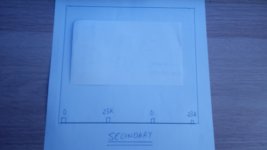I own a SUT with two primaries 0-40R parallel connected, to do the calculations for loading what's the primary value 20R because are connected in parallel?
Im not quite sure what your question is but I think 0-40R is the primaries DCR which doesnt affect the cartridge loading. If your going to do loading calculations you will
need to know what the step up ratio is. I think 2 primaries would have been provided to give you options for the step up. Connecting the primaries in series will give
you a given step up say 1:10 while connecting them in parallel will double it to 1:20. This will affect your loading calculations.
need to know what the step up ratio is. I think 2 primaries would have been provided to give you options for the step up. Connecting the primaries in series will give
you a given step up say 1:10 while connecting them in parallel will double it to 1:20. This will affect your loading calculations.
If the dcr for each primary is 40R then wiring them in parallel the total DCR is 20R but why are you using that for the
loading calculation or am I missing something ?
loading calculation or am I missing something ?
Sorry I cant read the writing on the SUT very well from the picture can you write it down? Also what make is it and what are you trying
to do with it ie iwhat cartridge into what i/p impedance , that may help. By the way you cant permanently magnetize the soft magnetic material
used for a SUT's core by passing measurement DC through the coil otherwise they wouldnt work. I do it all the time and I make SUT's. If you dont believe me read Q&As on the Sowter website.
to do with it ie iwhat cartridge into what i/p impedance , that may help. By the way you cant permanently magnetize the soft magnetic material
used for a SUT's core by passing measurement DC through the coil otherwise they wouldnt work. I do it all the time and I make SUT's. If you dont believe me read Q&As on the Sowter website.
Having a closer look I think it says 40R -23K on each coil. If so I think that means each coil is 1:24 ie the square root of 23000/40.
So if you parallel them up you would get 1:12. So with 1:24 a 47K secondary load will look like 82R to the cartridge
(if thats the application) and with 1:12 it would be 376R. Does that help ?
ps the 40R -23K doesnt mean that the primary coils dcr is 40R it means that the load seen on the primary will be 40R if the secondary
load is 23K and vice versa. So if you do parallel up the coils the load seen will be 20R. Is that what you meant ?
So if you parallel them up you would get 1:12. So with 1:24 a 47K secondary load will look like 82R to the cartridge
(if thats the application) and with 1:12 it would be 376R. Does that help ?
ps the 40R -23K doesnt mean that the primary coils dcr is 40R it means that the load seen on the primary will be 40R if the secondary
load is 23K and vice versa. So if you do parallel up the coils the load seen will be 20R. Is that what you meant ?
Last edited:
I see that the end of one coil is connected to the init of the other so they are in series, right?
Can you draw a schematic?
Walter
Can you draw a schematic?
Walter
Primary connected in parallel, secondary conected in series joined 23K and the two outputs 0
I own Denon DL103 0,3mV load 100 ohms & Linn Arkiv 150uV load>50 ohms
I own Denon DL103 0,3mV load 100 ohms & Linn Arkiv 150uV load>50 ohms
Last edited:
it is not right.
You have to connect 0-23-0-23 it is ok, series.
you must follow the direction of coil
Your connection is antiseries, the output is zero volt
You have to connect 0-23-0-23 it is ok, series.
you must follow the direction of coil
Your connection is antiseries, the output is zero volt
Felipe,
Are you read this?
https://www.audioasylum.com/cgi/t.mpl?f=vinyl&m=460964
John Elison 17:57:49 10/18/05
The final graph below compares the left channel for all three load conditions. The highest curve is 47k-ohms, the middle yellow curve is 100-ohms, and the bottom pink curve is 22-ohms. As you can see, there is hardly any difference—certainly not like the difference presented by Extremephono in their graph.
Are you read this?
https://www.audioasylum.com/cgi/t.mpl?f=vinyl&m=460964
John Elison 17:57:49 10/18/05
The final graph below compares the left channel for all three load conditions. The highest curve is 47k-ohms, the middle yellow curve is 100-ohms, and the bottom pink curve is 22-ohms. As you can see, there is hardly any difference—certainly not like the difference presented by Extremephono in their graph.
If you have a MC until 20 ohm as impedance the the primary must be parallel
If you have a 40 ohm MC as Denon DL103 you can put them in series.
Leaving in series the secondary
In the two cases the ratio changing and also the reflected impedance seen by MC ( if the Zin of the phono stay fix at 47 kohm as usual)
If you have a 40 ohm MC as Denon DL103 you can put them in series.
Leaving in series the secondary
In the two cases the ratio changing and also the reflected impedance seen by MC ( if the Zin of the phono stay fix at 47 kohm as usual)
- Home
- Source & Line
- Analogue Source
- SUT question


